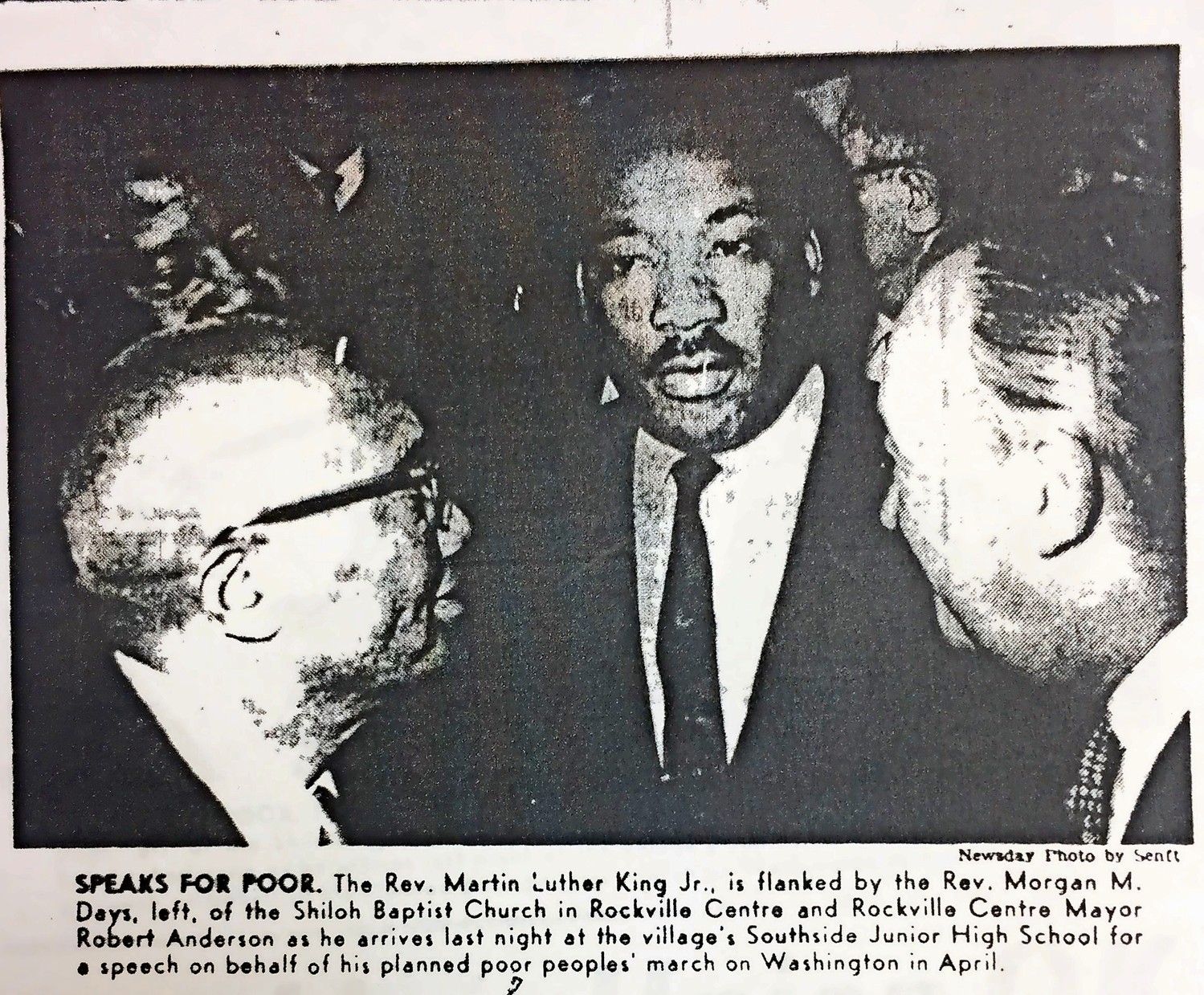50 years later, locals recall Dr. Martin Luther King Jr.’s visit to Rockville Centre
“When we heard him speak, we were overwhelmed,” said John Simpkins Jr., recalling the Rev. Dr. Martin Luther King Jr.’s visit to Long Beach and Rockville Centre in 1968.
Fifty years ago this month, King visited South Side Junior High School — now South Side Middle School — to address a packed auditorium after visiting the barrier island with residents and community activists earlier that day. He was shot and killed nine days later in Memphis, Tenn.
After marching through the streets with King on March 26, 1968, Simpkins, 70, a Long Beach resident at the time and former president of the Long Beach chapter of the NAACP, said he drove to Rockville Centre to see him speak to a few hundred middle-school students, parents and other community members.
“The spirits were high, and we actually weren’t planning on going to Rockville Centre until we walked through Long Beach,” Simpkins recounted. “. . . Sometimes you see something you like, and you want to follow it. You don’t want to let it go right then.”
King spoke about the Vietnam conflict, and the need for all races “to come together and work towards what America stands for: democracy, equality, education,” according to Simpkins.
“We were so mesmerized by the speech he gave,” he said. “It was something that was needed at that time on Long Island, in Long Beach and Rockville Centre.”
Catherine Pucciarelli, 83, of Rockville Centre, was sitting about 12 rows back on the right side of the stage, and recalled that King did not have notes, but spoke from the heart. “There was hardly a sound,” she said. “He just held the audience captive with his talk and the tone of his speech.”
Pucciarelli, a board member for the village’s Economic Opportunity Council who was active in the Rockville Centre Chapter of the Poor People’s Campaign, which King helped to create, recalled him touching on the topics of poverty, race relations and the Vietnam War. “It was not a voice of anger,” she noted. “It was a strong voice, but it was a voice of . . . understanding and wanting to have a change.”
David Ganz, who was a 16-year-old student at South Side High School at the time, stood in the back row of the auditorium. The speech, he recalled, also focused on the sanitation workers on strike in Memphis.
The strike started that February, and followed years of poor pay and dangerous working conditions. It was spurred by the deaths of sanitation workers Echol Cole and Robert Walker, who were crushed in a garbage packer, and was the reason King was in Memphis when he was killed on April 4.
“He was the kind of person who was willing to speak on any relevant topic of injustice,” said Ganz, who is now an elected freeholder in Bergen County, N.J. “. . . It turned out to be an extraordinary experience. In retrospect, I don’t think that I would have had the opportunity to talk about it this many years later. I certainly didn’t think so at the time.”
Hearing the Baptist minister address a crowd in person, he said, lived up to what he had heard about King, in terms of him being an “extraordinary speaker” who could inspire people. “I think that there’s something marvelous about that, and mind-changing,” he said.
Simpkins said he had attended King’s “I Have a Dream” speech in Washington in 1963, but enjoyed the more intimate setting in Rockville Centre, just feet away from King as he spoke. “It was up-close and personal, and it was profound for me,” he recalled.
The visit came at a time that Simpkins described as a decline in the civil rights movement. He characterized the climate on Long Island as “pretty tense” and one of segregation. African-Americans knew where they could live and where they couldn’t, he said. “They did it in a subtle matter,” Simpkins said of the racism. “It wasn’t in your face, but you got the message.” Today, changes have been made, he added, “but we’re not where we need to be.”
Two days after speaking in Rockville Centre, King was in Memphis for a rally in support of the sanitation workers, which turned violent when some protesters broke windows. A 16-year-old African-American boy, Larry Payne, was killed after the march, during which dozens were injured and hundreds were arrested. A week later, King was assassinated when he returned to Memphis in an effort to hold a peaceful march.
“When I heard the news he had been shot and killed, it was like feeling like a member of your family had died,” Pucciarelli said. “. . . I guess because we had seen him just a few weeks before, it was more personal. It was someone you knew.
“Listening to him, it was like he was talking to you, not just to an audience,” she continued, “and that’s a gift.”
To commemorate King’s visit, the Poor People’s Campaign organized a musical tribute a year later at the junior high school, Pucciarelli said, which was called “Many Faces of America.”
Five decades later, the memories of seeing King remain vivid for Pucciarelli, Simpkins and Ganz, who each remembered the mixed-race Rockville Centre crowd as a friendly one that offered the civil rights activist a warm welcome and a standing ovation.
“There are certain times in everyone’s life where they remember very clearly what happened,” Pucciarelli said. “This is one of them for me.”

 47.0°,
Mostly Cloudy
47.0°,
Mostly Cloudy 




